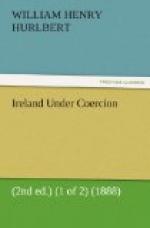The year 1878 saw the “Home Rule” movement in Irish politics brought to an almost ludicrous halt by the success of Mr. Parnell, then a young member of Parliament for Meath, in unhorsing the leader of that movement, Mr. Butt. As the Irish members then had no coherent purpose or policy, Mr. Parnell had, without much trouble, dominated and brigaded them to follow him blindly into a system of parliamentary obstruction, which there is reason to suppose was suggested to him by a friend who had studied the Congressional proceedings of the United States, the native country of his mother, and especially the tactics which had enabled Mr. Randall of Pennsylvania, the leader of the Democratic minority in the House of Representatives, to check the so-called “Civil Rights Bill,” sent down by the Senate to that House, during a continuous session of forty-six hours and a half, with no fewer than seventy-seven calls of the house, in the month of January 1875, some time before Mr. Parnell first took his seat in the House of Commons.
When Mr. Parnell, early in 1878, thanks to this system, had ousted Mr. Butt, and got himself elected as President of the Irish “Home Rule Confederation,” he found himself, as an Irish friend of mine wrote to me at the time, in an awkward position. He had command of the “Home Rule” members at Westminster, but he had no notion what to do with them, and neither they nor he could see anyway open to securing a permanent hold upon the Irish voters. Three bad harvests in succession had thrown the Irish tenants into a state which disinclined them to make sacrifices for any sentimental policy, but prepared them to lend their ears eagerly to Michael Davitt, when, on his return from the United States in the early spring of 1879, he proclaimed anew, at Irishtown in his native county of Mayo, the gospel of 1848 giving the land of Ireland to the people of Ireland. Clearly Mr. Davitt held the winning card. As he frankly put the case to a special correspondent, whom I sent to see him, and whose report I published in New York, he saw that “the only issue upon which Home Rulers, Nationalists, Obstructionists, and each and every shade of opinion existing in Ireland could be united was the Land Question,” and of that question he took control. Naturally enough, Mr. Parnell, himself a landowner under the English settlement, shrank at first from committing himself and his fortunes




